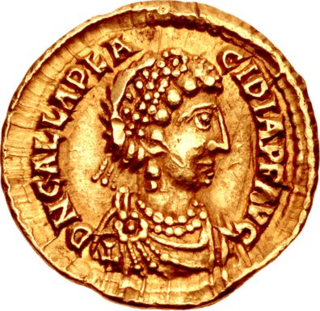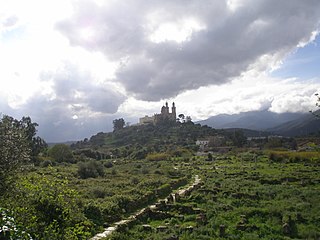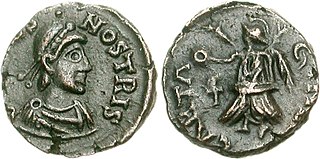
Galla Placidia, daughter of the Roman emperor Theodosius I, was a mother, tutor, and advisor to emperor Valentinian III, and a major force in Roman politics for most of her life. She was queen consort to Ataulf, king of the Visigoths from 414 until his death in 415, briefly empress consort to Constantius III in 421, and managed the government administration as a regent during the early reign of Valentinian III, until her death.
The 400s decade ran from January 1, 400, to December 31, 409.
The 470s decade ran from January 1, 470, to December 31, 479.
The 430s decade ran from January 1, 430, to December 31, 439.

Year 430 (CDXXX) was a common year starting on Wednesday of the Julian calendar. At the time, it was known as the Year of the Consulship of Theodosius and Valentinianus. The denomination 430 for this year has been used since the early medieval period, when the Anno Domini calendar era became the prevalent method in Europe for naming years.
The 420s decade ran from January 1, 420, to December 31, 429.
The 450s decade ran from January 1, 450, to December 31, 459.

Year 440 (CDXL) was a leap year starting on Monday of the Julian calendar. At the time, it was known as the Year of the Consulship of Valentinianus and Anatolius. The denomination 440 for this year has been used since the early medieval period, when the Anno Domini calendar era became the prevalent method in Europe for naming years

Year 434 (CDXXXIV) was a common year starting on Monday of the Julian calendar. At the time, it was known as the Year of the Consulship of Aspar and Areobindus. The denomination 434 for this year has been used since the early medieval period, when the Anno Domini calendar era became the prevalent method in Europe for naming years.

Year 450 (CDL) was a common year starting on Sunday of the Julian calendar, the 450th Year of the Common Era (CE) and Anno Domini (AD designations, the 450th year of the 1st millennium, the 50th year of the half of 5th century, and the 1st year of the 450s decade. At the time, it was known as the Year of the Consulship of Valentinianus and Avienus. The denomination 450 for this year has been used since the early medieval period, when the Anno Domini calendar era became the prevalent method in Europe for naming years.
The 390s decade ran from January 1, 390 to December 31, 399
The 440s decade ran from January 1, 440, to December 31, 449.
The 460s decade ran from January 1, 460, to December 31, 469.

Year 455 (CDLV) was a common year starting on Saturday of the Julian calendar. At the time, it was known as the Year of the Consulship of Valentinianus and Anthemius. The denomination 455 for this year has been used since the early medieval period, when the Anno Domini calendar era became the prevalent method in Europe for naming years.

Year 435 (CDXXXV) was a common year starting on Tuesday of the Julian calendar. At the time, it was known as the Year of the Consulship of Theodosius and Valentinianus. The denomination 435 for this year has been used since the early medieval period, when the Anno Domini calendar era became the prevalent method in Europe for naming years.

Marcian was Roman emperor of the East from 450 to 457. Very little of his life before becoming emperor is known, other than that he was a domesticus who served under the commanders Ardabur and his son Aspar for fifteen years. After the death of Emperor Theodosius II on 28 July 450, Marcian was made a candidate for the throne by Aspar, who held much influence because of his military power. After a month of negotiations Pulcheria, Theodosius' sister, agreed to marry Marcian. Zeno, a military leader whose influence was similar to Aspar's, may have been involved in these negotiations, as he was given the high-ranking court title of patrician upon Marcian's accession. Marcian was elected and inaugurated on 25 August 450.

Flavius Aetius was a Roman general and statesman of the closing period of the Western Roman Empire. He was a military commander and the most influential man in the Empire for two decades (433–454). He managed policy in regard to the attacks of barbarian federates settled throughout the West. Notably, he mustered a large Roman and allied (foederati) army in the Battle of the Catalaunian Plains, ending a devastating invasion of Gaul by Attila in 451, though the Hun and his subjugated allies still managed to invade Italy the following year, an incursion best remembered for the ruthless Sack of Aquileia and the intercession of Pope Leo I.

Flavius Ardabur Aspar was an Eastern Roman patrician and magister militum of Alanic-Gothic descent. As the general of a Germanic army in Roman service, Aspar exerted great influence on the Eastern Roman Emperors for half a century, from the 420s to his death in 471, through the reigns of Theodosius II, Marcian and Leo I, who, in the end, had him killed. His death led to the ending of the Germanic domination of Eastern Roman policy.
Foederati were peoples and cities bound by a treaty, known as foedus, with Rome. During the Roman Republic, the term identified the socii, but during the Roman Empire, it was used to describe foreign states, client kingdoms or barbarian tribes to which the empire provided benefits in exchange for military assistance. The term was also used, especially under the empire, for groups of "barbarian" mercenaries of various sizes who were typically allowed to settle within the empire.

Bonifatius was a Roman general and governor of the diocese of Africa. He campaigned against the Visigoths in Gaul and the Vandals in north Africa. An ally of Galla Placidia, mother and advisor of Valentinian III, Bonifacius engaged in Roman civil wars on her behalf against the generals Felix in 427-429 and Aetius in 432. Although he defeated the latter at the Battle of Rimini, Bonifacius suffered a fatal wound and was succeeded by his son-in-law Sebastianus as patricius of the Western Roman Empire.









